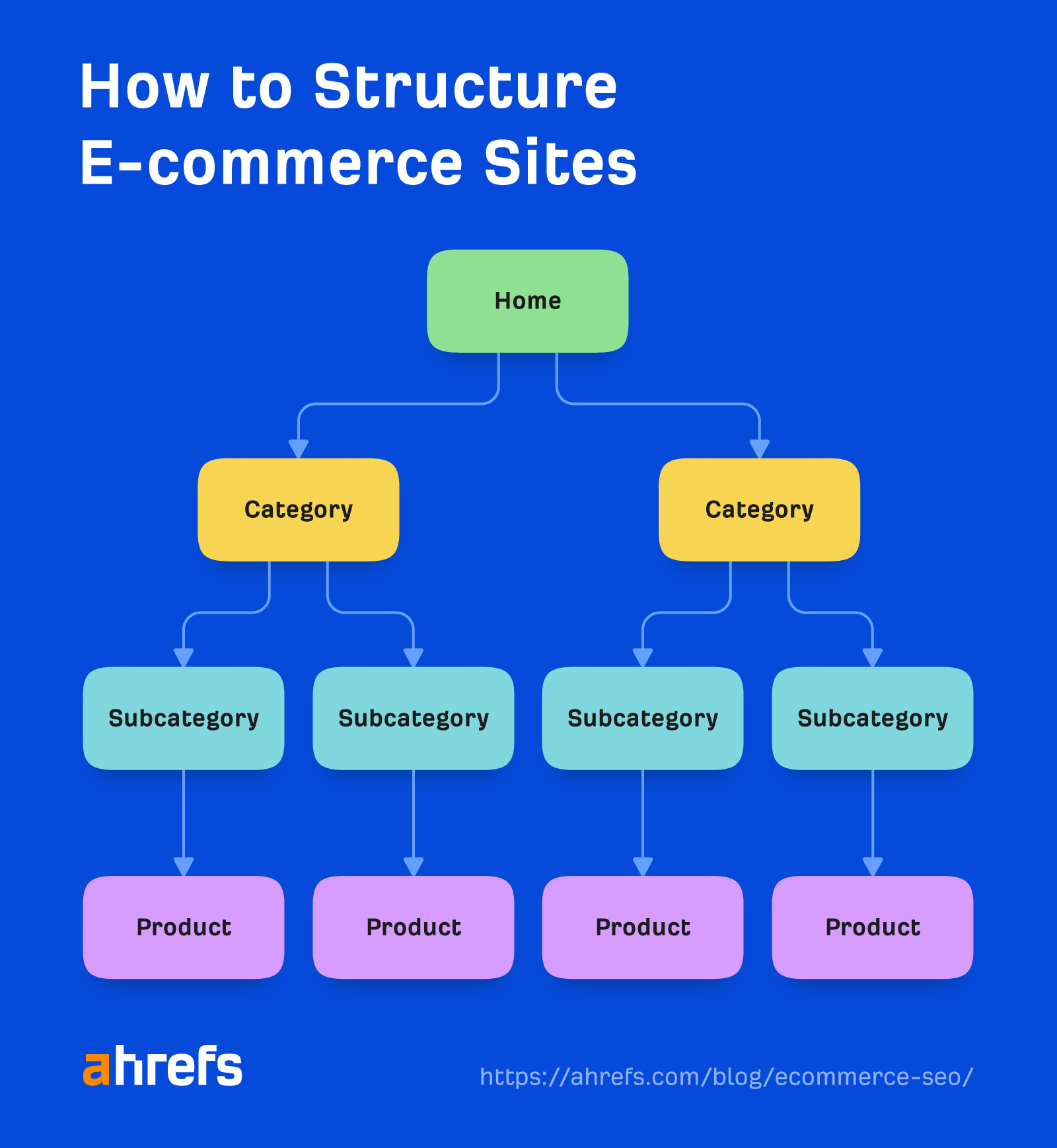[ad_1]
If you want to drive more potential customers to your online store, e-commerce SEO may be just the ticket.
Keep reading to learn what it is, why it’s important, and how to master it.
E-commerce SEO is the process of optimizing an online store to improve its visibility and rankings in search engines like Google. It focuses heavily on improving the performance of category and product pages, as these tend to be the most lucrative.

It’s generally a more cost-effective way to reach your customers rather than bidding on expensive paid advertising keywords.
Technical SEO may seem the most daunting starting point, but it’s crucial for e-commerce sites. That’s mainly because of issues relating to faceted navigation, but there are also a few things to keep in mind. Let’s go through them.
Secure your site with HTTPS
HTTPS is a secure protocol for transferring data between websites and visitors. It prevents hackers from stealing sensitive information that visitors commonly share with online stores, such as their name, address, and credit card details.
It’s also been a minor Google ranking factor since 2014.
You’ll know if your store uses HTTPS because it’ll have a “padlock” icon in the address bar that looks like this:

Most popular e-commerce platforms use HTTPS, so it shouldn’t be a concern for most people. But if it is, make sure to fix it.
Make your site structure easy to navigate
Site structure is how your website’s pages are organized and interlinked.
Most e-commerce stores organize their pages roughly like this:

Here are two reasons why this structure makes sense:
- It’s easy to navigate – Visitors can find what they’re looking for in just a few clicks.
- It helps Google find your pages – Google can “follow” internal links from page to page.
Getting your site structure right from the start also means you’ll avoid the headache of redesigning it later on.
When it comes to internal links, it’s best to keep it simple to start with. You can use the arrows in the illustration above as guidance on how to interlink your pages.
For example, your homepage should link to your category pages, which should link to the relevant subcategory pages, which should link to the relevant products.
Implement faceted navigation correctly to give your pages the best chance at ranking
Faceted navigation allows visitors to filter the products on category and subcategory pages.
Here’s what it looks like:

Despite its usefulness for visitors, it can cause serious SEO issues for e-commerce websites because filter combinations often create new parameterized URLs.
For example, if you filter for on-ear headphones, it may create a URL like this:
/headphones/?color=red&brand=sony&type=wired
Even if you only have a handful of filters, there can be thousands of combinations. That means thousands of new URLs that Google can end up crawling and potentially indexing.
That isn’t good because it can:
- Weaken important pages’ ability to rank – Filter combinations can often lead to the creation of multiple URLs with the same content. Unless Google realizes this (which doesn’t always happen), ranking signals will get split between the duplicate pages.
- Prevent Google from crawling important pages – Google will only devote finite resources to crawling your site. If it has to crawl a load of junk, it may not have the resources to crawl all important pages.
There are various solutions to these issues. For beginners and intermediates, a simple option is to canonicalize faceted URLs to their master category or subcategory.
Some e-commerce SEO platforms do this out of the box. Check if this is the case for your site by installing Ahrefs’ SEO Toolbar, visiting a few faceted URLs, and checking the “Indexability” tab. If the canonical URL is non-faceted, chances are this isn’t an issue on your site.
Here’s an example of this in action:

Keyword research helps you understand how people search for what you sell. You can use this knowledge to create subcategories and product pages that cater to search demand. Let’s look at how to do this.
Find keywords for subcategory pages
Subcategory pages show the types of products you sell in a category.
For example, a “headphones” category may have subcategories like “wired” and “wireless.”
You probably already know some subcategories that make sense for your store. But as people search in many ways, it’s useful for SEO to create subcategories that align with those terms.
Here’s how to find ideas for subcategories in Ahrefs’ Keywords Explorer:
- Enter a few broad keywords related to your category
- Go to the Matching terms report
- Look for the types of things you sell
Here are a few ideas for the “headphones” subcategories:

Note that this isn’t all about search volumes. You should use common sense and choose terms that make sense as subcategories.
For example, “audio technica open ear headphones” won’t be a suitable subcategory because it’s too specific. The same is true for “bone conduction headphones” unless you sell more than a couple of pairs.
Here’s a quick cheat sheet for choosing subcategories for SEO:

Sidenote.
Generally speaking, you shouldn’t choose more than a handful of subcategories. It makes your navigation messy and convoluted. Three to 10 is enough for most stores.
Repeat the process for other categories.
Find keywords for product pages
Product keyword research isn’t really a thing if you sell branded products, as people will search for the products themselves.
For example, there are an estimated 622K monthly searches in the U.S. for “airpods pro.”

If you sell these headphones, your product page already targets that keyword.
However, if you’re selling unbranded products or products from unknown names, you may want to find and target more descriptive terms that people search for.
For example, let’s say you sell a pair of cat ear headphones. Unless people are specifically searching for the brand or model, it may be better to target a relevant keyword that people actually search for, such as “cat ear headphones.”

Tip
Keep search intent in mind when doing this. If the top search results for a keyword are all e-commerce category pages, this may indicate that searchers want a choice. In this case, it may be better to target the keyword with a subcategory page or faceted URL (more on those later).
On-page SEO is the process of optimizing the content on your page. It includes optimizations to the content you see and code under the hood. Let’s go through a few considerations and optimizations for e-commerce sites.
Save time with title tag, meta description, and H1 templates
Most e-commerce stores use templates for their title tags and meta descriptions.
Here’s an example of a meta description template.

Using a templated approach makes sense because writing unique copy for thousands of product and category pages is nobody’s idea of fun. Unfortunately, it can lead to stale, duplicate copy that doesn’t entice clicks.
You can solve this with a hybrid approach where you use templates for most pages but unique ones for those with the most search traffic.
Here’s how to find pages with the most search traffic in Google Search Console (GSC):
- Go to the Search results report
- Select the “Pages” tab

If you don’t use GSC, you can get a free estimate in Ahrefs’ Site Audit with an Ahrefs Webmaster Tools account.
- Select your project in Site Audit
- Go to the Page Explorer
- Filter for internal pages
- Sort by organic traffic from highest to lowest

For H1s, it’s simple—just use the category or product name.

Use simple and descriptive URLs
Here’s a simple template that works for category and subcategory pages:
domain.com/category/subcategory/
For example, here are a few categories and subcategories for our audio store that follow this template:
domain.com/headphones/ domain.com/headphones/wireless domain.com/headphones/wired domain.com/headphones/over-ear domain.com/headphones/in-ear
Things are a little more complicated when it comes to products because the obvious structure will be this:
domain.com/category/subcategory/product
However, as products often fall into multiple categories, this can lead to duplicate content. In other words, the same product is available at various URLs.
For example, AirPods are both wireless and in-ear headphones, so they’ll end up with two URLs:
domain.com/headphones/in-ear/airpods domain.com/headphones/wireless/airpods
You can solve this problem by using this template for product URLs:
domain.com/product
Add unique product and category descriptions to help visitors and Google
Product and category pages often have little to no content. That isn’t necessarily bad, but adding unique descriptions can help Google and visitors better understand the page.
Here are a few tips for doing this:
- Keep them short and sweet
- Make sure they’re descriptive and helpful
- Mention long-tail keywords
To find long-tail variations and synonyms, plug a competing product or category page for your main target keyword into Ahrefs’ Site Explorer and check the top 10 rankings in the Organic keywords report.

For example, here are a few notable keywords that one of the top-ranking pages for “wireless headphones” also ranks for:
- bluetooth headphones
- wireless earphones
- bluetooth earbuds
It will be easy and natural to mention these words in the page’s description.
Link building for e-commerce stores is hard because there’s usually no value for someone else to link to a product or category page. However, there are a few tried and tested methods. You can also use other methods to get links to your homepage. Let’s go over a few tactics.
Use the “product feedback” technique to get featured
If you have products that only you sell, the “product feedback” technique can help you get featured on lists of the best products in that category.
Here’s the process:
- Find popular lists of the best products
- Offer the author your product in return for feedback
- Ask them to consider including it on their list (if they like the product)
Given that most authors will link to the products they feature, this is a straightforward way to build links directly to product pages.
To find lists of the best products that don’t mention yours, search Google for best[product category] -brandname.

Alternatively, run an “In title” search in Ahrefs’ Content Explorer for the same thing and filter for pages with traffic to find popular lists.

For example, here’s a list of the best smart speakers that don’t mention any Sonos speakers:

If Sonos wants to build more links to one of its smart speaker product pages, it can offer to send the product to the author for free in return for feedback. If the author loves it, Sonos can ask the author if they’ll consider featuring it in their post.
Tip
Never explicitly offer to send authors your product in exchange for a link. It could lead to a penalty because Google sees “exchanging goods or services for links” as a link scheme.
Claim unlinked brand mentions in reviews
Unlinked mentions are online mentions of your products or brand without a link to your site.
They can happen for all kinds of reasons. However, they’re often difficult to turn into links because there’s rarely an obvious or compelling pitch angle.
For example, here’s an unlinked mention for Audio-Technica:

Unfortunately, in this case, there’s no compelling pitch angle. That’s because the unlinked mention is in an article about a band selling gear to fund music education, and there are no links to other mentioned brands.
However, if someone reviews your product and doesn’t link to you, asking them to link to the official product page so readers can learn more about the product is a logical and at least somewhat compelling angle.
You can find unlinked reviews with Ahrefs’ Web Explorer, which searches an index of billions of pages. Just enter this search: Intitle:[your brand] review...
[ad_2]


